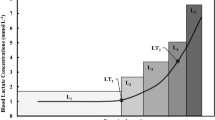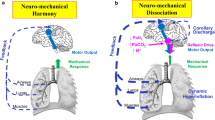Abstract
Purpose
To determine clinical safety and cardiovascular, cardiac autonomic and inflammatory responses to a single session of inspiratory muscle training (IMT) in obstructive sleep apnea (OSA) subjects.
Methods
In a randomized controlled trial individuals of both sexes, aged between 30 and 70 years old with diagnosis of moderate to severe OSA were enrolled. Volunteers with OSA (n = 40) performed an IMT session with three sets of 30 repetitions with a 1-min interval between them. The IMT group (n = 20) used a load of 70% of the maximum inspiratory pressure (MIP), and the placebo group (n = 20) performed the IMT without load. Measurements of systolic blood pressure (SBP), diastolic blood pressure (DBP), heart rate (HR), heart rate variability (HRV), and inflammatory markers were performed pre, post-immediate and 1 h after the IMT session.
Results
No differences were shown in SBP, DBP, HRV, or inflammatory markers at any of the intervals analyzed. However, HR in the IMT group was lower 1 h after the IMT session compared to the pre-session values (p = 0002). HR was higher in the placebo group when comparing pre × post-immediate (p < 0.001). HR decreased after the first hour in relation to the pre (p < 0.001) and post-immediate (p < 0.001) values.
Conclusion
IMT sessions promote discreet hemodynamic, cardiac autonomic and inflammatory responses. Therefore, IMT is considered clinically safe and can be performed at home, guided but unsupervised, with lower cost and greater adherence to exercise program for subjects with OSA.




Similar content being viewed by others
References
Choi JH, Thomas RJ, Suh SY, Park IH, Kim TH, Lee SH, Lee HM, Yun CH, Lee SH (2015) Sleep quality change after upper airway surgery in obstructive sleep apnea: electrocardiogram-based cardiopulmonary coupling analysis. Laryngoscope 125:1737–1742. https://doi.org/10.1002/lary.25101
Lavie L, Lavie P (2009) Molecular mechanisms of cardiovascular disease in OSAHS: the oxidative stress link. Eur Respir J 33:1467–1484. https://doi.org/10.1183/09031936.00086608
Andrade FMD, Pedrosa RP (2016) O papel do exercício físico na apneia obstrutiva do sono. J Bras Pneumol 42:457–464. https://doi.org/10.1590/S1806-37562016000000156
Mendelson M, Bailly S, Marillier M, Flore P, Borel JC, Vivodtzev I, Doutreleau S, Verges S, Tamisier R, Pépin JL (2018) Obstructive sleep apnea syndrome, objectively measured physical activity and exercise training interventions: a systematic review and meta-analysis. Front Neurol 9:73. https://doi.org/10.3389/fneur.2018.00073
Herkenrath SD, Treml M, Priegnitz C, Galetke W, Randerath WJ (2017) Effects of respiratory muscle training (RMT) in patients with mild to moderate obstructive sleep apnea (OSA). Sleep Breath 22:323–328. https://doi.org/10.1007/s11325-017-1582-6
Souza AKF, Andrade AD, Medeiros AIC, Aguiar MIR, Rocha TDS, Pedrosa RP, Lima AMJ (2018) Effectiveness of inspiratory muscle training on sleep and functional capacity to exercise in obstructive sleep apnea: a randomized controlled trial. Sleep Breath 22:631–639. https://doi.org/10.1007/s11325-017-1591-5
Vranish JR, Bailey EF (2016) Inspiratory muscle training improves sleep and mitigates cardiovascular dysfunction in OSA. SLEEP 39:1179–1185. https://doi.org/10.5665/sleep.5826
Katayama K, Saito M (2019) Muscle sympathetic nerve activity during exercise. J Physiol Sci 69:589–598. https://doi.org/10.1007/s12576-019-00669-6
Benini R, Nunes PRP, Orsatti CL, Portari GV, Orsatti FL (2015) Influence of sex on cytokines, heat shock protein and oxidative stress markers in response to an acute total body resistance exercise protocol. J Exerc Sci Fit 13:1–7. https://doi.org/10.1016/j.jesf.2014.10.002
Cwikiel J, Seljeflot I, Berge E, Njerve IU, Ulsaker H, Arnesen H, Flaa A (2018) Cytokine effect of strenuous exercise on mediators of inflammation in patients with coronary artery disease. Cytokine 105:17–22. https://doi.org/10.1016/j.cyto.2018.02.006
Bertolazi AN, Fagondes SC, Hoff LS, Dartora EG, Miozzo IC, Barba ME, Barreto SS (2011) Validation of the Brazilian Portuguese version of the Pittsburgh sleep quality index. J Clin Sleep Med 2:70–75. https://doi.org/10.1016/j.sleep.2010.04.020
Bertolazi AN, Fagondes SC, Hoff LS, Pedro VD, Barreto SSM, Johns MW (2009) Validação da escala de sonolência de Epworth em português para uso no Brasil. J Bras Pneumol 35(9):877–883. https://doi.org/10.1590/S1806-37132009000900009
Matsudo S, Araújo T, Matsudo V, Andrade D, Andrade E, Oliveira LC, Braggion G (2001) International physical activity questionnaire (IPAQ): study of validity and reability in Brazil. Rev Bras Ativ Fís Saúde 6(2):05–18. https://doi.org/10.12820/rbafs.v.6n2p5-18
American Thoracic Society/ European Respiratory Society (2002) ATS/ERS statement on respiratory muscle testing. Am J Resp Crit Care 166:518–624. https://doi.org/10.1164/rccm.166.4.518
Pessoa IMBS, Neto MH, Montemezzo D, Silva LAM, Andrade AD, Parreira VF (2014) Predictive equations for respiratory muscle strength according to international and Brazilian guidelines. Braz J Phys Ther 18:410–418. https://doi.org/10.1590/bjpt-rbf.2014.0044
Pereira CAC, Duarte AAO, Gimenez A, Soares MR (2014) Comparação entre os valores de referência para CVF, VEF1 e relação VEF1/CVF em brasileiros caucasianos adultos e aqueles sugeridos pela Global Lung Function Initiative 2012. J Bras Pneumol 40:397–402. https://doi.org/10.1590/S1806-37132014000400007
(1996) Heart rate variability: standards of measurement, physiological interpretation and clinical use. Task force of the European society of cardiology and the North American society of pacing and electrophysiology. Circulation 93(5):1043–1065
Mitchell JH (2012) Neural control of the circulation during exercise: insights from the 1970-1971 Oxford studies. Exp Physiol 97:14–19. https://doi.org/10.1113/expphysiol.2011.058156
Vianna LC, Oliveira RB, Ramos PS, Ricardo DR, Araújo CG (2010) Effect of muscle mass on muscle mechanoreflex-mediated heart rate increase at the onset of dynamic exercise. Eur J Appl Physiol 108:429–434. https://doi.org/10.1007/s00421-009-1237-9
Ramos PS, Silva BC, Silva LOG, Araújo CG (2015) Acute hemodynamic and electrocardiographic responses to a session of inspiratory muscle training in cardiopulmonary rehabilitation. Eur J Phys Rehabil Med 51:773–779
Bonsignore MR, Baiamonte P, Mazzuca E, Castrogiovanni A, Marrone O (2019) Obstructive sleep apnea and comorbidities: a dangerous liaison. Multidiscip Respir Med 14:1–12. https://doi.org/10.1186/s40248-019-0172-9
Plentz RDM, Silva VGS, Dipp T, Macagnan FE, Lemos LC, Tartari JLL, Sbruzzi G (2014) Inspiratory muscle training in autonomic control in healthy individuals. Salud (i) Ciencia 21:28–34
Abboud F, Kumar R (2014) Obstructive sleep apnea and insight into mechanisms of sympathetic overactivity. J Clin Invest 124:1454–1457. https://doi.org/10.1172/JCI70420
Mansukhani MP, Kara T, Caples S, Somers VK (2014) Chemoreflexes, sleep apnea, and sympathetic dysregulation. Curr Hypertens Rep 16:476. https://doi.org/10.1007/s11906-014-0476-2
Silva FOC, Macedo DV (2011) Exercício físico, processo inflamatório e adaptação: uma visão geral. Rev Bras de Cineantropom Desempenho Hum 13:320–328. https://doi.org/10.5007/1980-0037.2011v13n4p32
Windsor MT, Bailey TG, Perissiou M, Meital L, Golledge J, Russel FD, Askew CD (2018) Cytokine responses to acute exercise in healthy older adults: the effect of cardiorespiratory fitness. Front Physiol 9:1–8. https://doi.org/10.3389/fphys.2018.00203
Cullen MT, Thomas AW, Webb R, Hughes MG (2016) Interleukin-6 and associated cytokine responses to an acute bout of high intensity interval exercise: the effect of exercise intensity and volume. Appl Physiol Nutr Metab 41:803–808. https://doi.org/10.1139/apnm-2015-0640
Steensberg A, Van Hall G, Osada T, Sacchetti BS, Pedersen BK (2000) Production of interleukin-6 in contracting human skeletal muscles can account for the exercise-induced increase in plasma interleukin-6. J Physiol 529:237–242. https://doi.org/10.1111/j.1469-7793.2000.00237.x
Kheirandish-Gozal L, Gozal D (2019) Obstructive sleep apnea and inflammation: proof of concept based on two illustrative cytokines. Int J Mol Sci 20:459. https://doi.org/10.3390/ijms20030459
Li L, Ren F, Qi C, Xu L, Fang Y, Liang M, Feng J, Chen B, Ning W, Cao J (2018) Intermittent hypoxia promotes melanoma lung metastasis via oxidative stress and inflammation responses in a mouse model of obstructive sleep apnea. Respir Res 19:1–9. https://doi.org/10.1186/s12931-018-0727-x
Availability of data and materials
The datasets generated during and/or analyzed during the current study are available from the corresponding author on reasonable request.
Code availability
Not applicable
Funding
This study was financed in part by the Coordenação de Aperfeiçoamento de Pessoal de Nível Superior - Brasil (CAPES) - Finance Code 001
Author information
Authors and Affiliations
Contributions
Sílvia Thamilis Barbosa Pessoa Ferreira — acquisition, analysis and interpretation of data and drafting the manuscript
Juliana Baptista Teixeira and Thayse Neves Santos Silva — acquisition of data
Michelle Christiane da Silva Rabello, Virgínia Maria Barros de Lorena, and Breno Quintella Farah — analysis and/or interpretation of data
Maria do Socorro Brasileiro-Santos — revising the manuscript critically for important intellectual content
Anna Lima Jaguaribe de Lima — conception and design of study, analysis, and/or interpretation of data and revising the manuscript critically for important intellectual content. All the authors read and approved the manuscript.
Corresponding author
Ethics declarations
Ethics approval
All procedures performed in studies involving human participants were in accordance with the ethical standards of the institutional and/or national research committee and with the 1964 Helsinki declaration and its later amendments or comparable ethical standards.
Informed consent
Informed consent to participate for publication was obtained from all individual participants included in the study.
Conflict of interest
All authors certify that they have no affiliations with or involvement in any organization or entity with any financial interest (such as honoraria; educational grants; participation in speakers’ bureaus; membership, employment, consultancies, stock ownership, or other equity interests; and expert testimony or patent-licensing arrangements) or non-financial interest (such as personal or professional relationships, affiliations, knowledge, or beliefs) in the subject matter or materials discussed in this manuscript.
Additional information
Publisher’s note
Springer Nature remains neutral with regard to jurisdictional claims in published maps and institutional affiliations.
ReBEC: RBR – 74497t 23/03/2020
Rights and permissions
About this article
Cite this article
Ferreira, S.T.B.P., do Socorro Brasileiro-Santos, M., Teixeira, J.B. et al. Clinical safety and hemodynamic, cardiac autonomic and inflammatory responses to a single session of inspiratory muscle training in obstructive sleep apnea. Sleep Breath 26, 99–108 (2022). https://doi.org/10.1007/s11325-021-02364-6
Received:
Revised:
Accepted:
Published:
Issue Date:
DOI: https://doi.org/10.1007/s11325-021-02364-6




